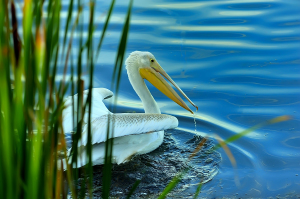There have been many discussions about the buttons on the back of the dslrs. I am going to discuss the topic of back button focusing. The shots of the white pelican are a great example of how using it can help.
This pelican kept gliding away from me as I walked around a large lake. I got several longer distance shots but I wanted the close-ups. We all want to get a chance to get close-ups on some of our shots. I decided to get well ahead of the bird and wait on it to come to me. A standard technique for shooting animals in the wild is to hide and let them act naturally and come to you. Sometimes it works and other times it does not but chasing them is a total waste and the shots usually are not very good.
I shoot with a camera that has two buttons on the back of the camera, the AE-L, AF-L and the auto focus on button. I do not use the AE,AF lock button. I do use back button focusing and the reason is very simple. I shoot images of wildlife. Many shots like the one of the white pelican require waiting several minutes and the opening is small. This shot I was sitting on a water inlet that is about two feet wide and almost water level. The cattails surround it for quite a distance. I had a very small window to shoot the image with the bird up close.
If you use the shutter release to focus the camera refocuses when you release and push down again. This slows down the reaction time, can cause an image to be out of focus and you just might miss the shot totally. Try holding a heavy camera with a long lens and battery pack up to your eye holding the shutter release half way down for 3 or 4 minutes or longer. I cannot do that and even if I could I would probably shake the camera and it would refocus every time it moved. That is not an issue when you use the back button AF technique. By shutting off the shutter release focus you take control of when the camera focuses or refocuses.
This shot I did at 1/250, f/7.1 and ISO 800. The ISO is higher to allow for more ambient light to get in as it was approaching late evening. The bird was in the shadow area of the lake with the sun behind it. I had a pretty good depth of field and the shutter speed was good enough to capture the movement even the water drops. I focused using the AF/ON button and put the camera in my lap. When the pelican came around the cattails all I had to do was pick up the camera and shoot. No need for a time lapse or lens to refocus. I pushed the button and held it while taking the other shots just like continuous focusing by holding down the shutter release. The difference is in the beginning of the sequence as I was not tired, the camera was not shaking and I got the shot I wanted. As fast as the pelican came around the cattails I do not know if I would have gotten the shot even with the fast focusing lenses. I had previously decided on the composition of the shot so I had positioned myself and the lens was zoomed to cover the area I wanted. The only thing left to chance was the bird itself. The pelican was about ten feet away. For the rest of the world that would be about three meters.
I strongly suggest trying this technique as you take control of the camera. If you read my articles you know I shoot in manual about ninety percent of the time. This technique takes a little getting used to doing and on some cameras it can be a pain as they do not have an AF-on button. Those need to have a button reassigned. I cannot put instructions on here on how to do that with every camera but most new models have the capability of using the technique even if you have to reassign a button.
This technique only works if you have your camera set for continuous focusing. On most cameras there is a switch on the front of the camera next to the lens that has letters like C,S, M or A . That switch needs to be set to C and in the menus you need to set the auto focus activation to OFF and on the sub menu set it to AF/ON only. Most will have two choices, Shutter/AF-ON. You can change back and forth easy if you add this to your custom menu on the Nikons. I do not know about Canon as I have used them for years.
Give the technique some time to work for you. Do not take chances on important shoots by trying something new as the client may not like you missing a shot because you were playing with the camera. Once you get the hang of it you will see it is very fast, works as well or better than the shutter release and you have complete control of when the camera focuses not the camera. We have all had shots go bad because the lens is refocusing because something in the frame changed.
click on image to enlarge. More images on www.davidgeorgephotography.net
